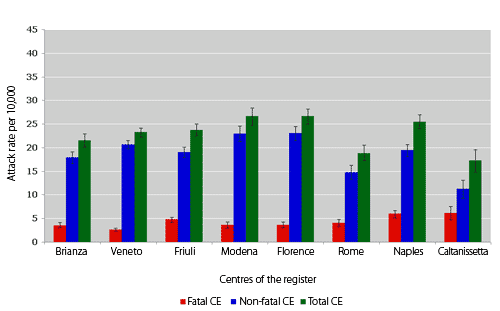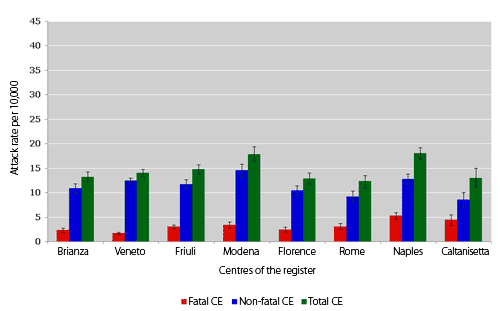The attack rate
of cerebrovascular events differs in the several areas of the
country.
Look at the graphs and read the data for men
and
women.
MenAttack rate of
cerebrovascular events per 10,000 men aged 35-74 years is:
-
Brianza: 21.5 for all events, 3.5 for fatal and
18.0 for non-fatal events
-
Veneto: 23.2 for all events, 2.6 for fatal and
20.6 for non-fatal events
-
Friuli: 23.7 for all events, 4.8 for fatal and
19.0 for non-fatal events
-
Modena: 26.6 for all events, 3.7 for fatal and
23.0 for non-fatal events
-
Florence: 26.6 for all events, 3.6 for fatal
and 23.0 for non-fatal events
-
Rome: 18.8 for all events, 4.1 for fatal and
14.7 for non-fatal events
-
Naples: 25.4 for all events, 6.0 for fatal and
19.5 for non-fatal events
-
Caltanissetta: 17.3 for all events, 6.1 for
fatal and 11.2 for non-fatal events
Attack rate (per 10,000) of cerebrovascular events by
geographical area.
Men aged 35-74 years

Women
Attack rate of cerebrovascular events per 10,000 women aged 35-74
years is:
-
Brianza: 13.1 for all events, 2.3 for fatal and
10.8 for non-fatal events
- Veneto: 14.0 for all events, 1.6 for fatal
and 12.4 for non-fatal events
- Friuli: 14.7 for all events, 3.0 for fatal
and 11.7 for non-fatal events
- Modena: 17.8 for all events, 3.3 for fatal
and 14.5 for non-fatal events
- Florence: 12.9 for all events, 2.4 for
fatal and 10.5 for non-fatal events
- Rome: 12.3 for all events, 3.1 for fatal
and 9.2 for non-fatal events
- Naples: 18.1 for all events, 5.3 for fatal
and 12.8 for non-fatal events
-
Caltanissetta: 12.9 for all events, 4.4 for
fatal and 8.6 for non-fatal events.
Attack rate (per 10,000) of cerebrovascular events by
geographical area.
Women aged 35-74 years

Data were collected within the
Registro nazionale degli eventi coronarici e cerebrovascolari
maggiori and refer to the two-year period 1998-1999.

